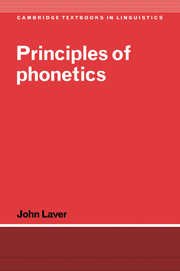Book contents
- Frontmatter
- Contents
- List of figures
- List of tables
- Preface
- Acknowledgements
- Introduction
- PART I General concepts
- PART II The analytic framework
- PART III Initiation and phonation
- PART IV Linear segmental analysis
- PART V Articulatory co-ordination and phonetic settings
- 12 Intersegmental co-ordination
- 13 Phonetic similarity and multisegmental settings
- PART VI Temporal, prosodic and metrical analysis
- PART VII Principles of transcription
- PART VIII Conclusion
- Envoi
- Appendix I The phonetic alphabet of the International Phonetic Association
- Appendix II Index of languages
- References
- Index of names
- Subject index
12 - Intersegmental co-ordination
Published online by Cambridge University Press: 05 June 2012
- Frontmatter
- Contents
- List of figures
- List of tables
- Preface
- Acknowledgements
- Introduction
- PART I General concepts
- PART II The analytic framework
- PART III Initiation and phonation
- PART IV Linear segmental analysis
- PART V Articulatory co-ordination and phonetic settings
- 12 Intersegmental co-ordination
- 13 Phonetic similarity and multisegmental settings
- PART VI Temporal, prosodic and metrical analysis
- PART VII Principles of transcription
- PART VIII Conclusion
- Envoi
- Appendix I The phonetic alphabet of the International Phonetic Association
- Appendix II Index of languages
- References
- Index of names
- Subject index
Summary
Segments have been described so far as instances of segment-types, and discussion has been focused on the defining characteristics of the segments concerned, as if each were occurring as an individual event isolated in time and independent of neighbouring articulatory context. This was helpful for initial exposition, and at that stage it was unnecessary to say very much about the detailed nature of the onset and offset transitions of segments. We now need to move beyond this initial approach, however, because in real speech segments cannot occur in isolation. As serial elements of a multisegmental utterance of continuous speech, all segments have contextual neighbours. These are either adjacent segments on both sides, or a segment on one side and utterance-marginal silence on the other. Even as single segments, a segment has contextual neighbours of utterance-marginal silence on both sides. In all cases, the articulatory events that make up the segment concerned have to be co-ordinated with those of the neighbouring context.
The detailed mode of this integrating co-ordination is open to phonetic and phonological control, and the articulation of segments can therefore show a variety of co-ordinatory relationships with the contexts in which they are embedded. These relationships involve some of the most interesting and intricate phenomena in the control of speech production, and give rise to issues that have often been found problematic. A range of different types of co-ordination is described in the sections below.
- Type
- Chapter
- Information
- Principles of Phonetics , pp. 339 - 390Publisher: Cambridge University PressPrint publication year: 1994



